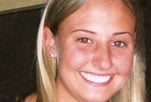Anna Frutiger embodied brains, beauty, compassion, and athleticism, and seemed the picture of health while she was living her dream of becoming a dentist. No one expected that a blood clot would end her life, and it seemed beyond belief that Anna died on May 20, 2010 from a pulmonary embolism (PE) due to an undiagnosed deep vein thrombosis (DVT), a month after her 23rd birthday.
Anna felt pain behind her knee and in her calf four months before she died and attributed it to her half marathon training. Her friends at dental school noted that she limped, and Anna became short of breath when she ran.
Anna saw an orthopedic surgeon who found no injury to suggest a muscle pull. After a thorough physical and review of her medical history, her doctor suspected a blood clot in her lower leg. Anna’s only known risk factor was that she was taking a third generation birth control pill. Results of an ultrasound/Doppler of her leg were negative for DVT. At a follow-up three weeks later, her leg was normal shape and size, and she no longer felt any leg pain. As a result, her doctor discharged her.
After her first-year finals at the University of Pittsburgh School of Dental Medicine, Anna traveled quite a bit. She flew for six hours over two consecutive weekends, then went to see friends in New York City the next two weekends, which involved an eight hour bus trip with one 10-minute stop. Anna complained of not being able to breathe easily when she carried groceries up to her apartment right after the bus trip. She told her parents that her symptoms were probably stress–related.
The next morning, Anna called her best friend to drive her to school because she felt extremely weak and didn’t think she could walk on her own. She wanted to push herself to class because she had two quizzes that day. Anna collapsed on the lawn outside her apartment after walking downstairs. Her friend called 9-1-1 and an ambulance arrived within minutes. Anna was conscious at that point and asked her friends to call her parents in Michigan.
Anna made it to the emergency room, but had a cardiopulmonary arrest a few minutes after she arrived. She was immediately taken to surgery to try to dislodge the blood clot that caused her PE. Over the next two days, a team of doctors and nurses worked round the clock to keep Anna alive in hopes that a miracle would happen. Her family was euphoric two days later when she moved her arms during the night, and hoped she would awake from her coma. However, neurological tests showed that she no longer had brain activity. Anna’s family had to make the agonizing decision to remove life support, and they chose to donate her organs.
Her doctors tested her family and found no genetic blood clotting disorders. Her autopsy determined that Anna was not predisposed to blood clots. It seems that the birth control pill and her concentrated travel in one month were her major clotting risks.
Her family believes that if Anna had the knowledge of the risks factors and signs of DVT, she might be alive today.
Anna loved her friends and family with every ounce of her being and always gave 110% to others, no matter what was at stake. Two of her closest friends, Sally Vitez and Michael Ratajczyk, fundraised more than $7,000 for NBCA by running a marathon and half marathon, respectively, in Anna’s memory.
Anna’s family is sharing her story to show that a blood clot can happen to anyone, at any age, and at any time, and that awareness of signs and symptoms of DVT and PE helps save lives. Anna’s story has already saved the lives of several individuals who had similar symptoms and sought medical care for blood clots or testing for clotting disorders. Her story prompted them to seek care immediately for similar symptoms, and because of the impact of Anna’s story, lives were saved.
The Frutiger family is committed to doing everything in their power to support public awareness efforts of National Blood Clot Alliance to Stop The Clot.




